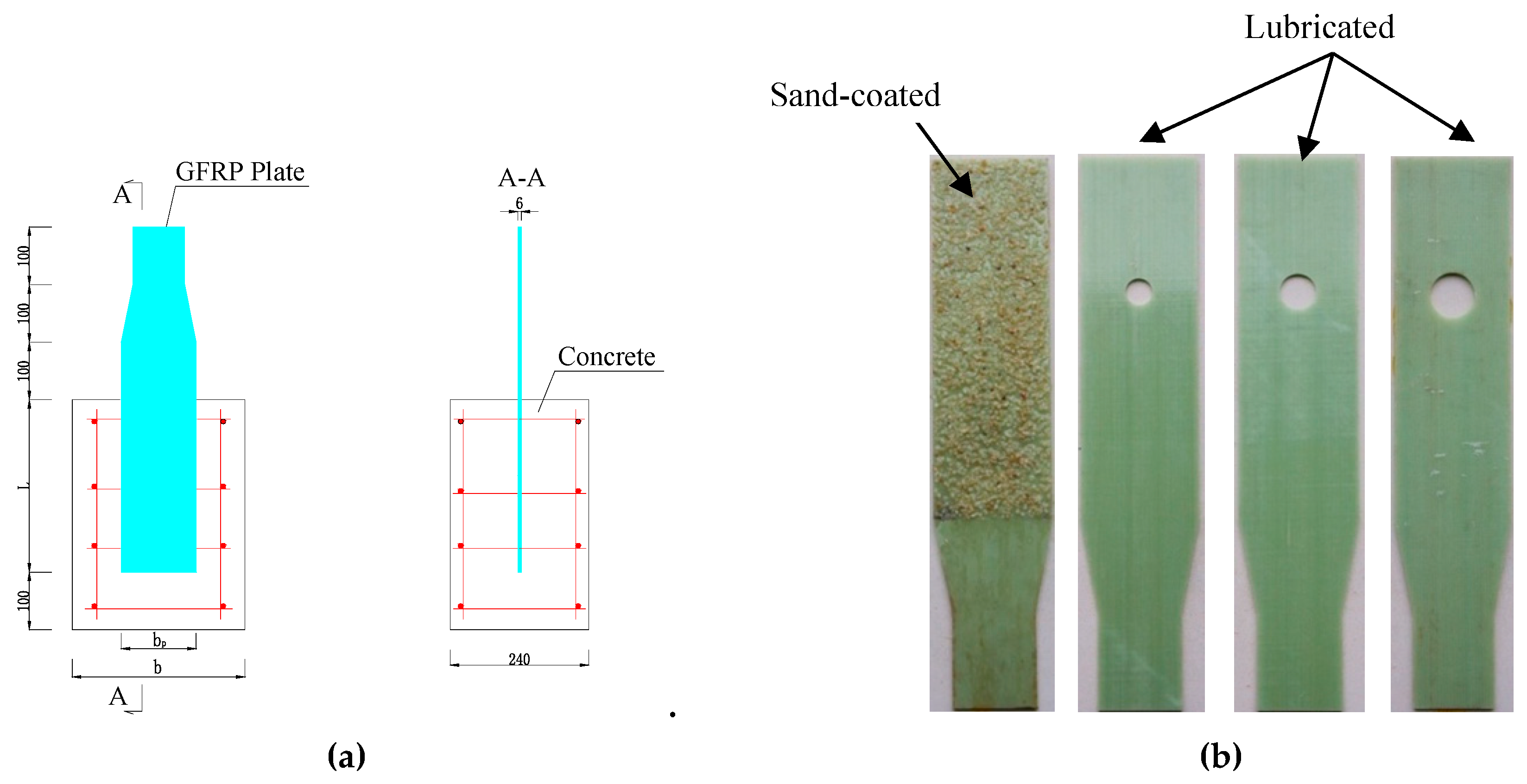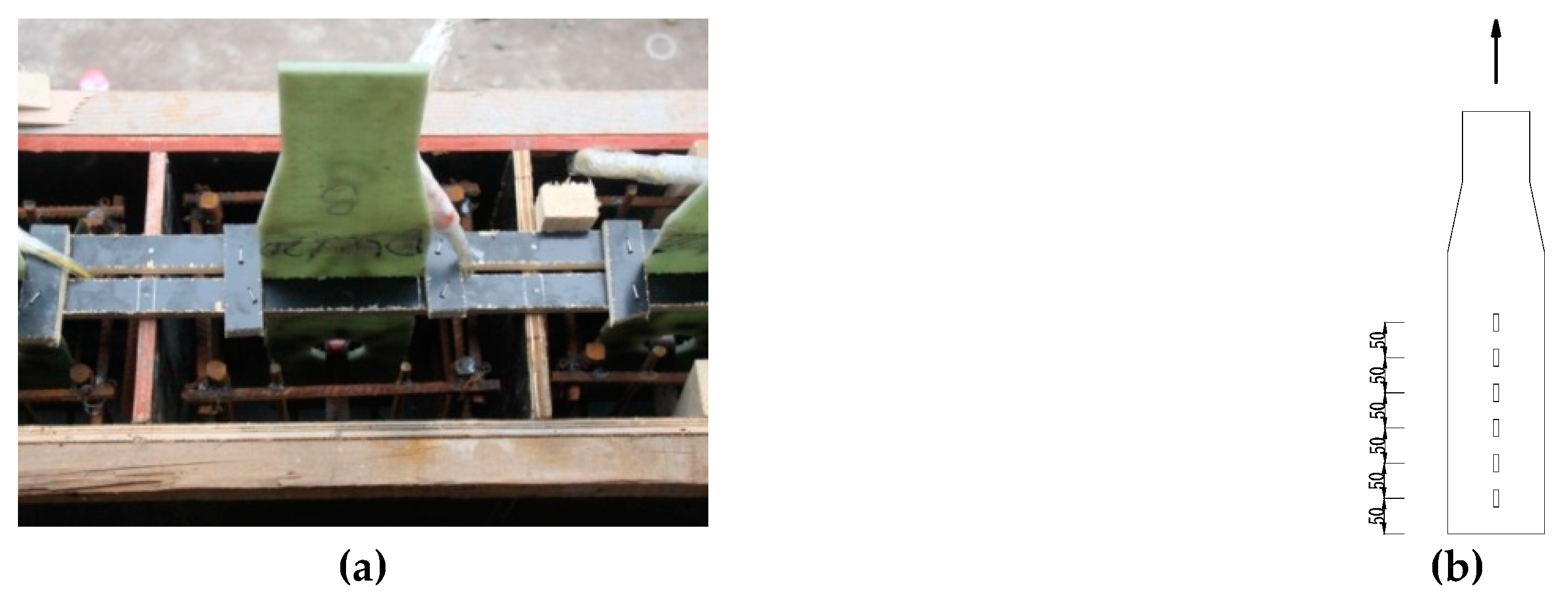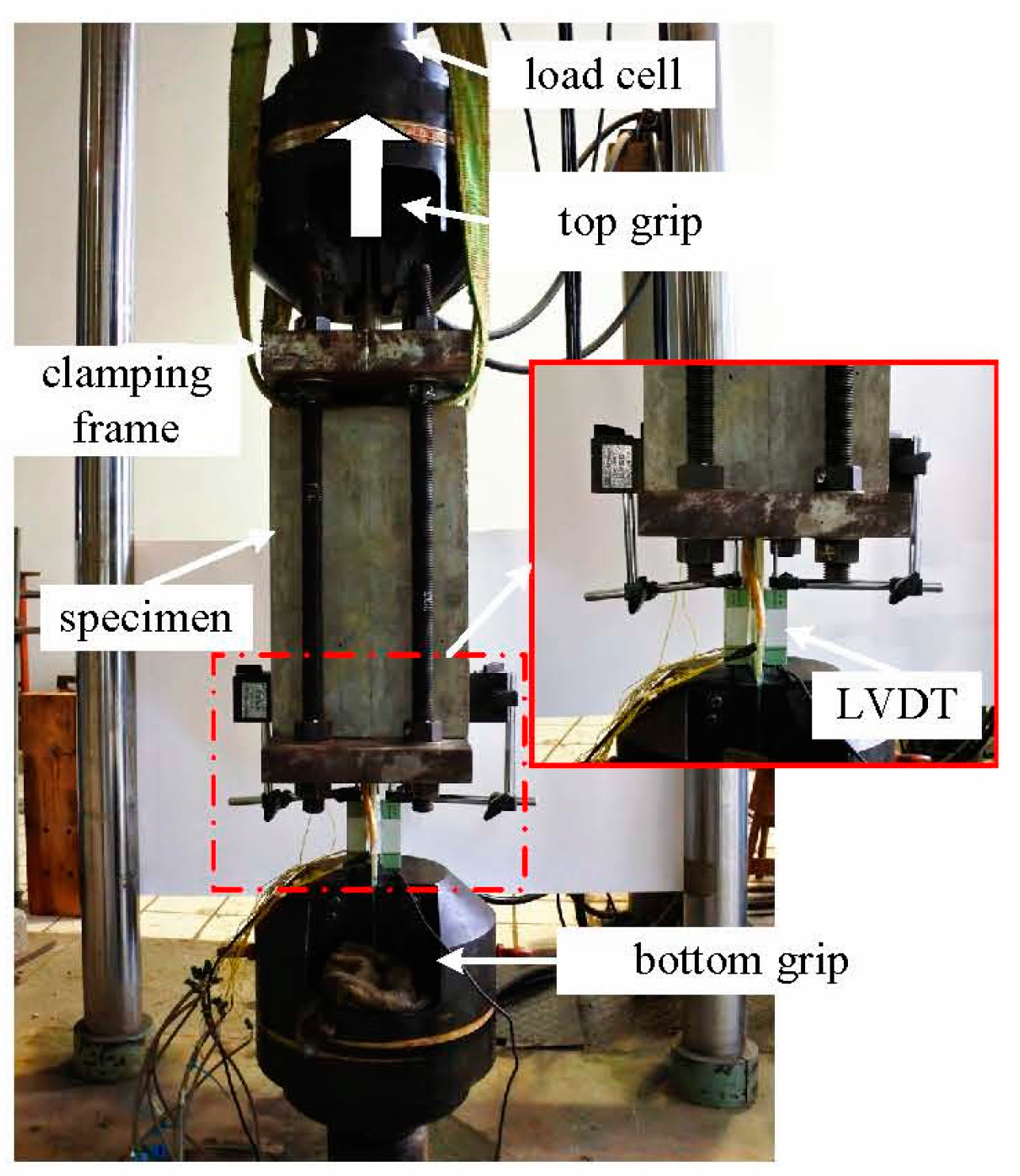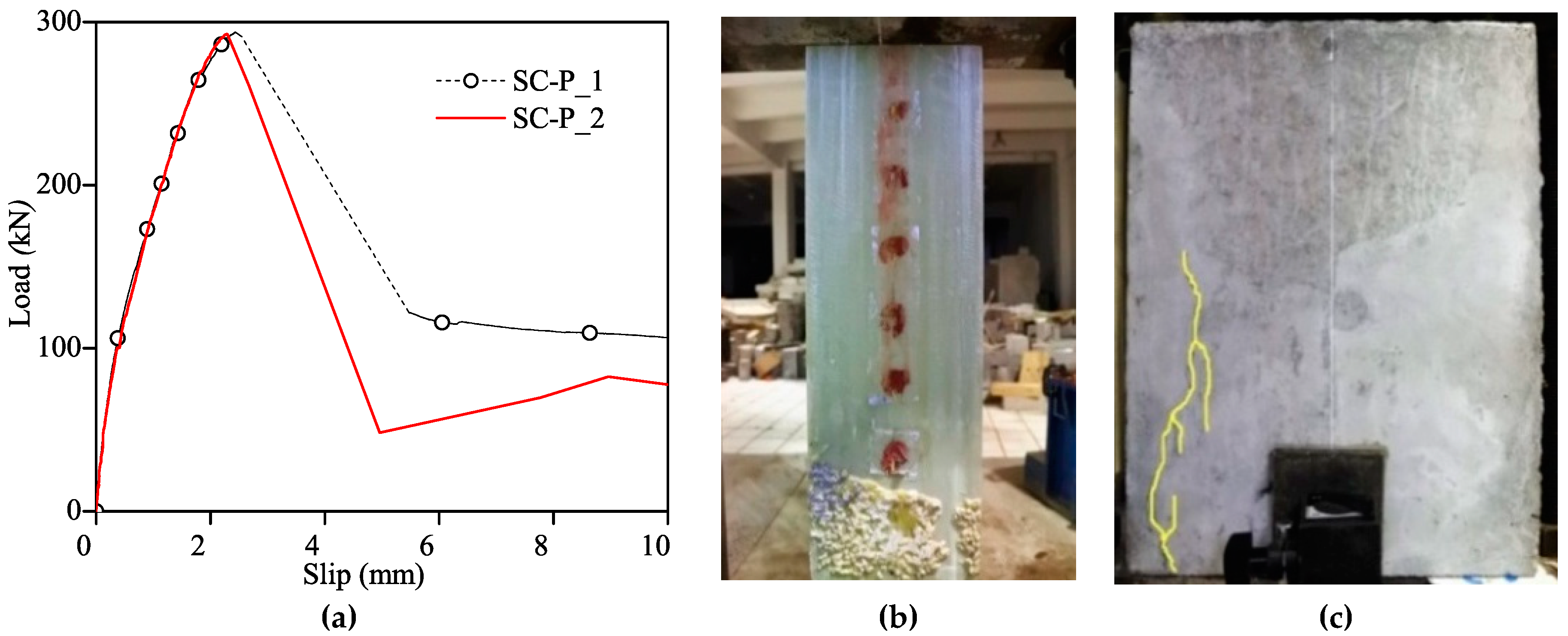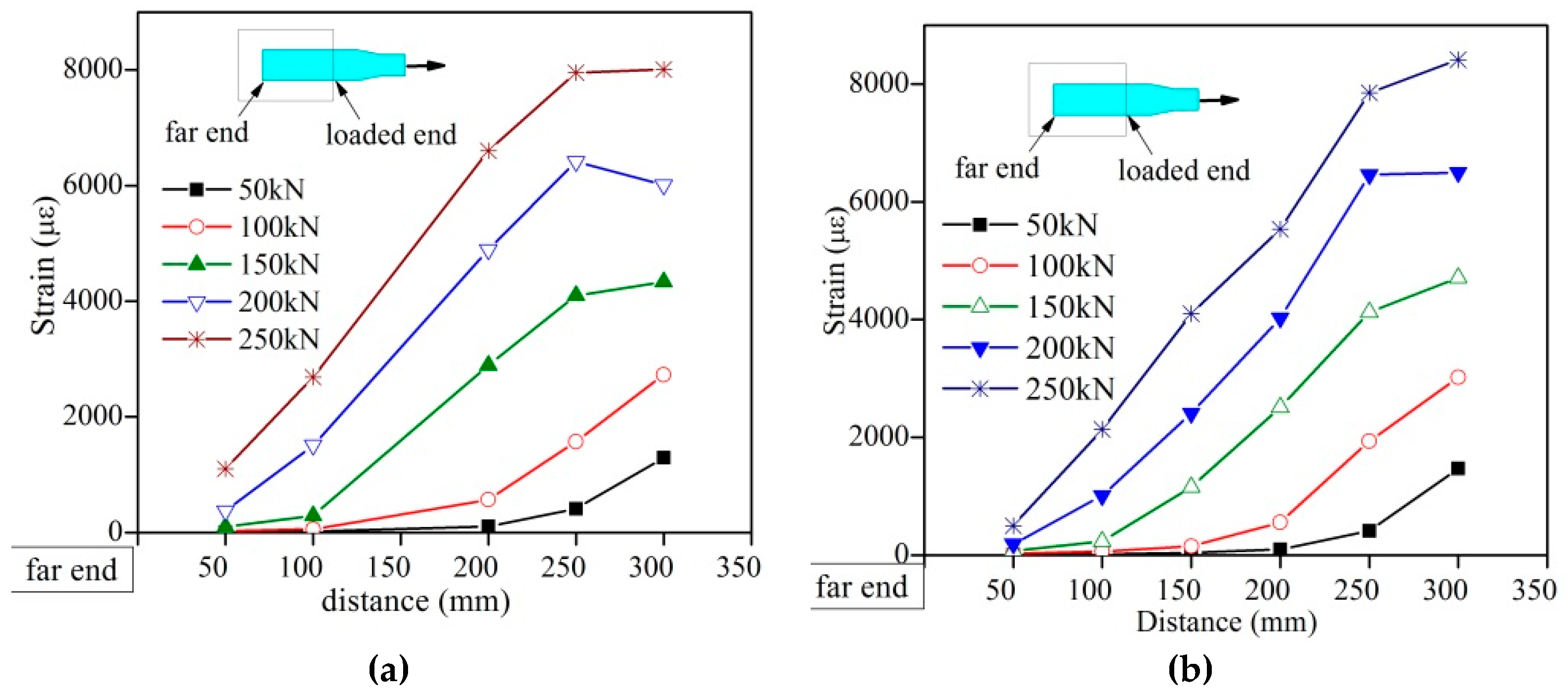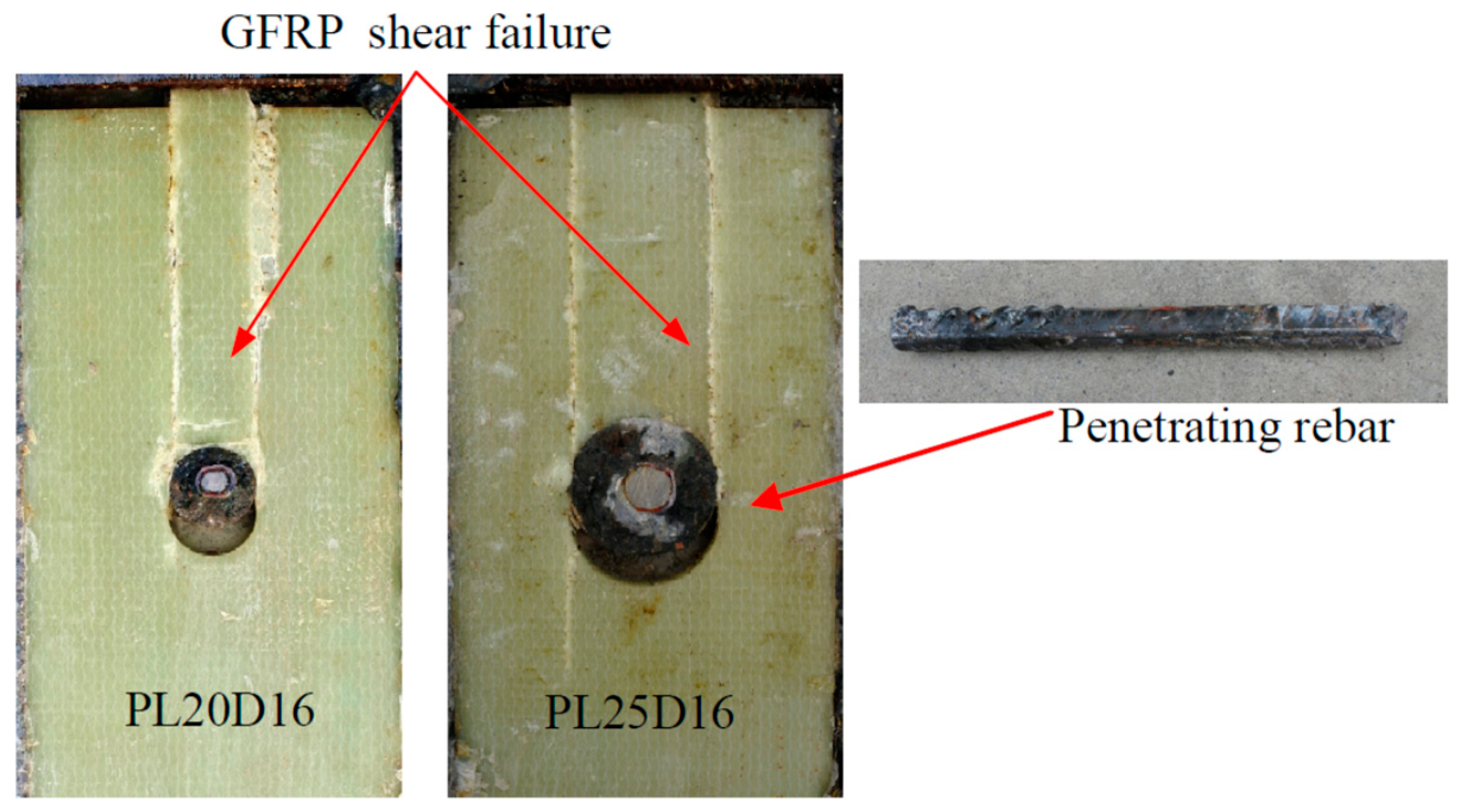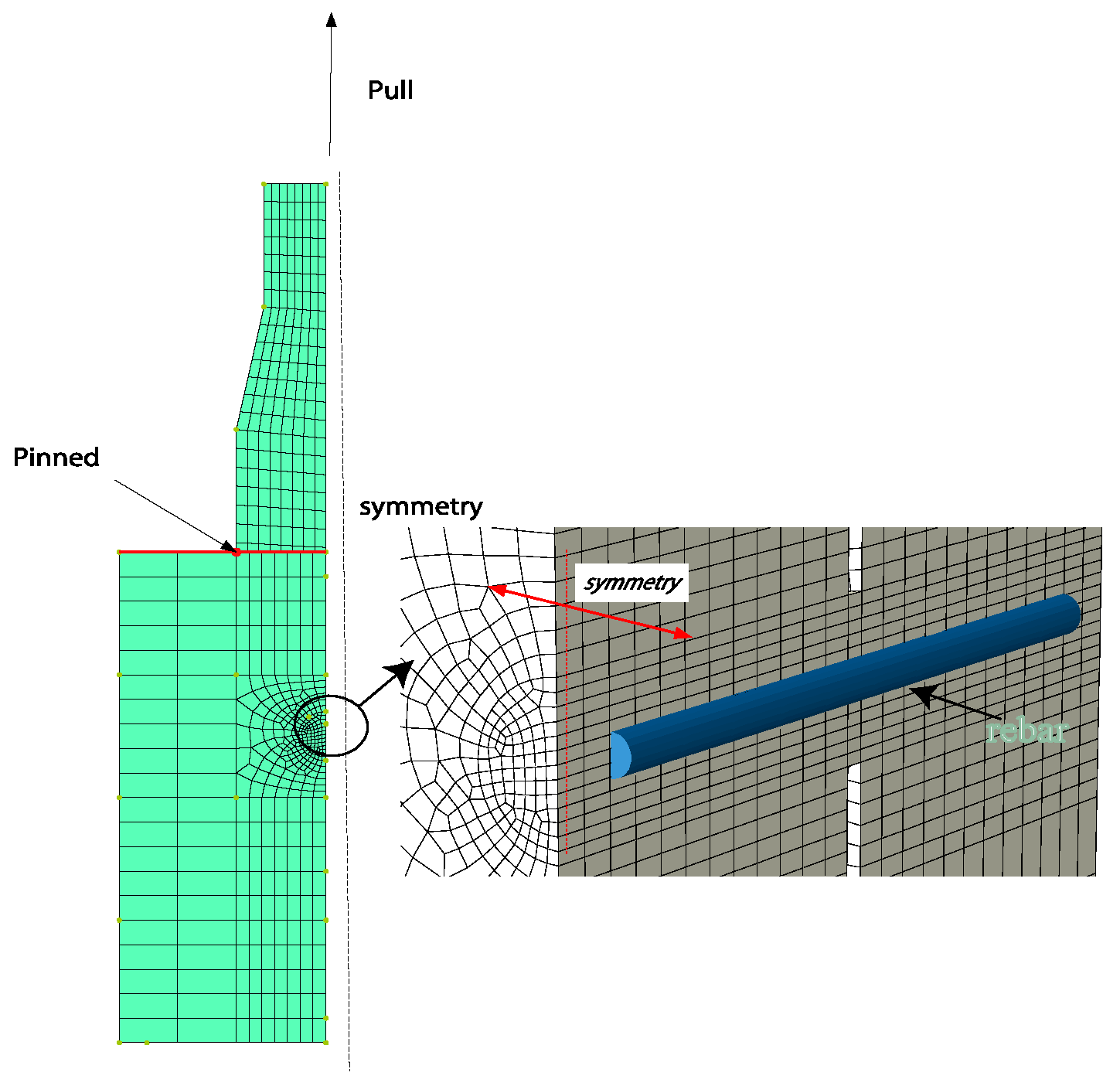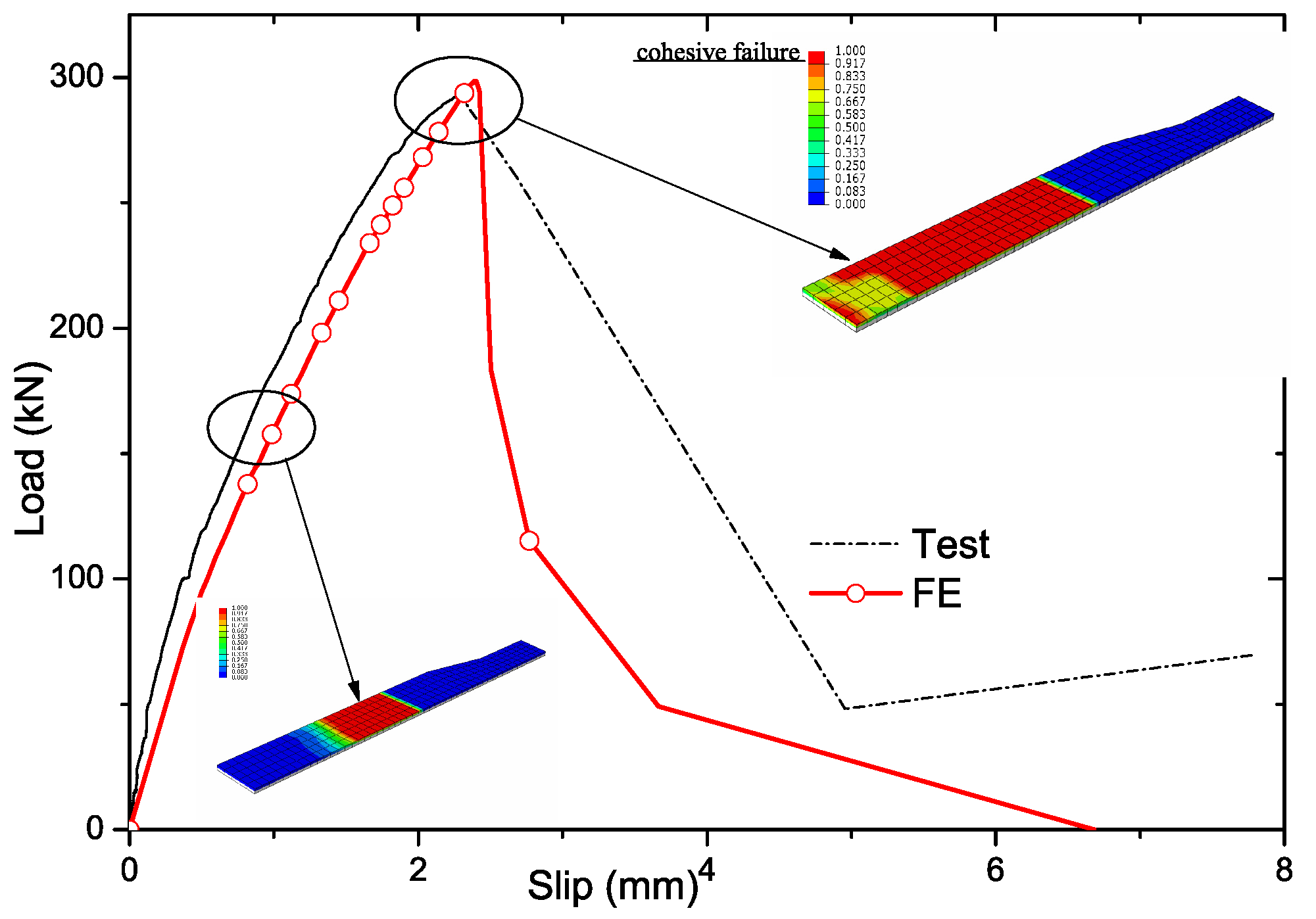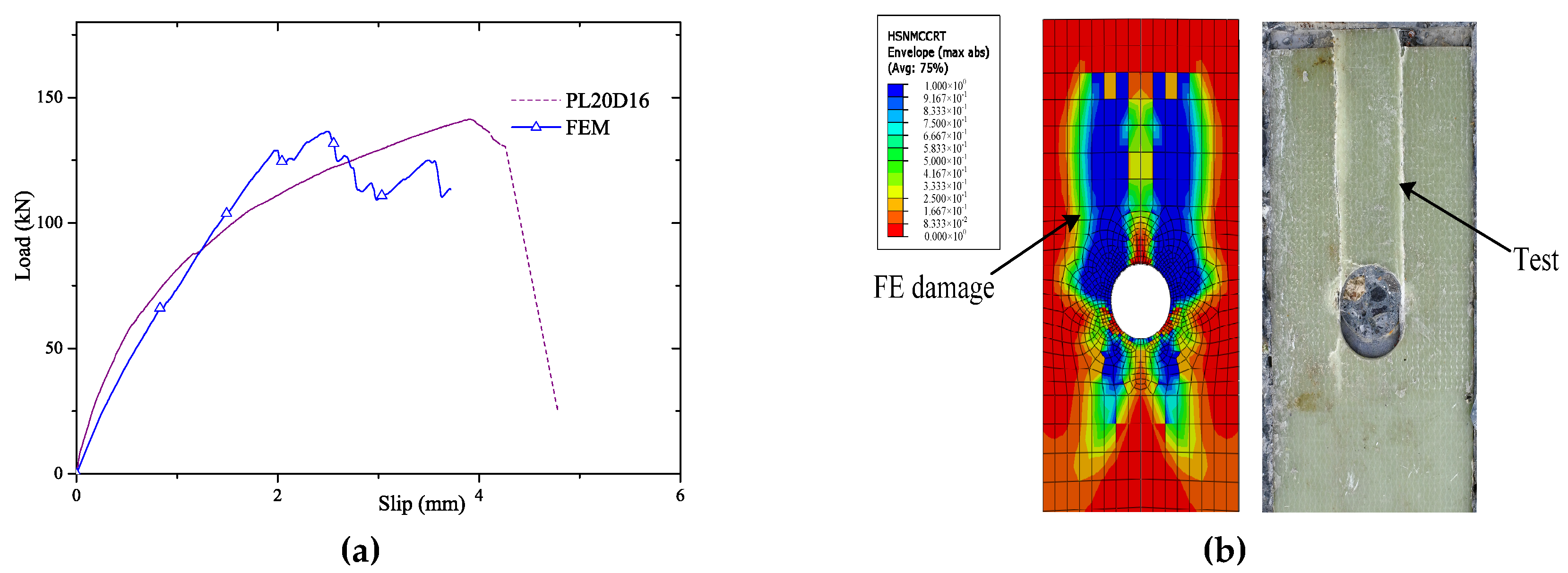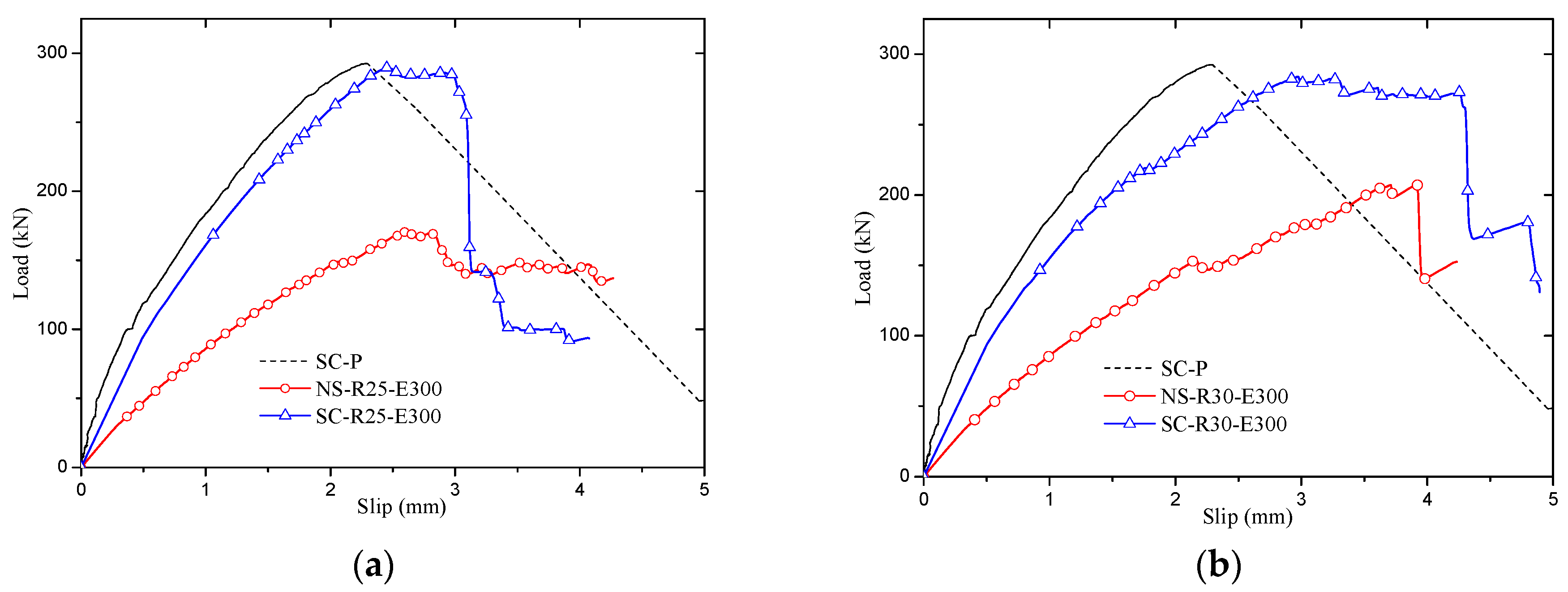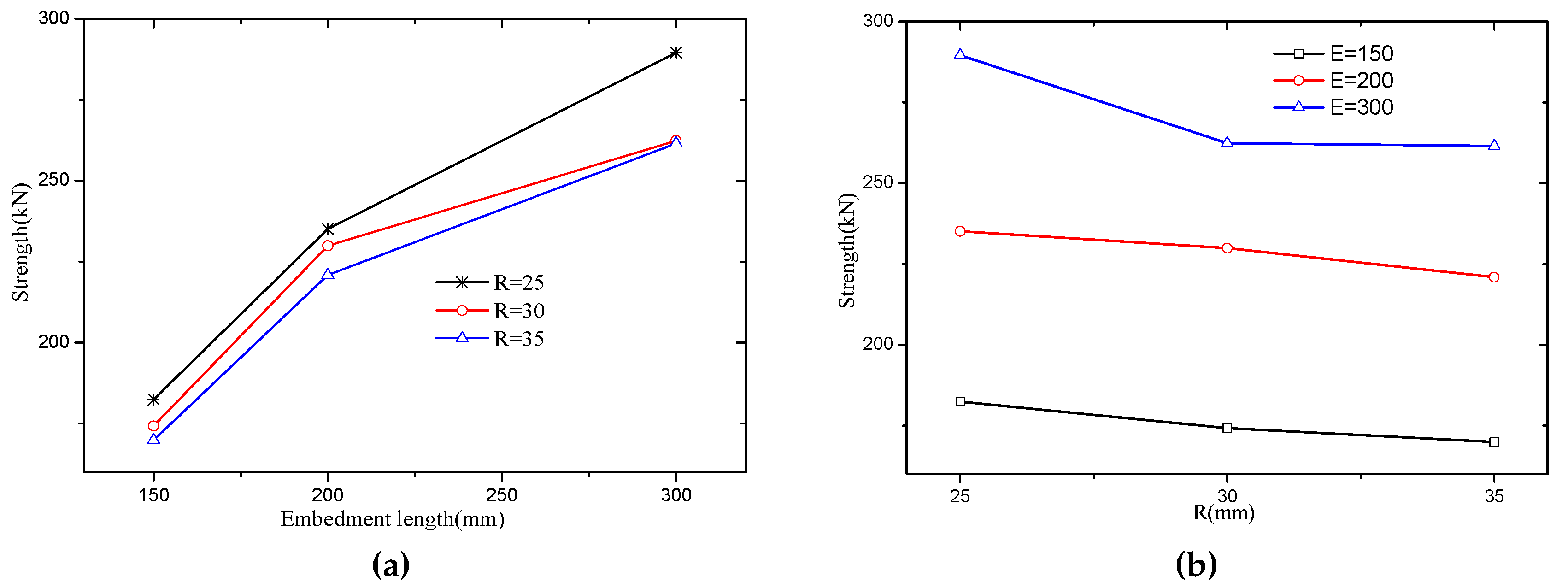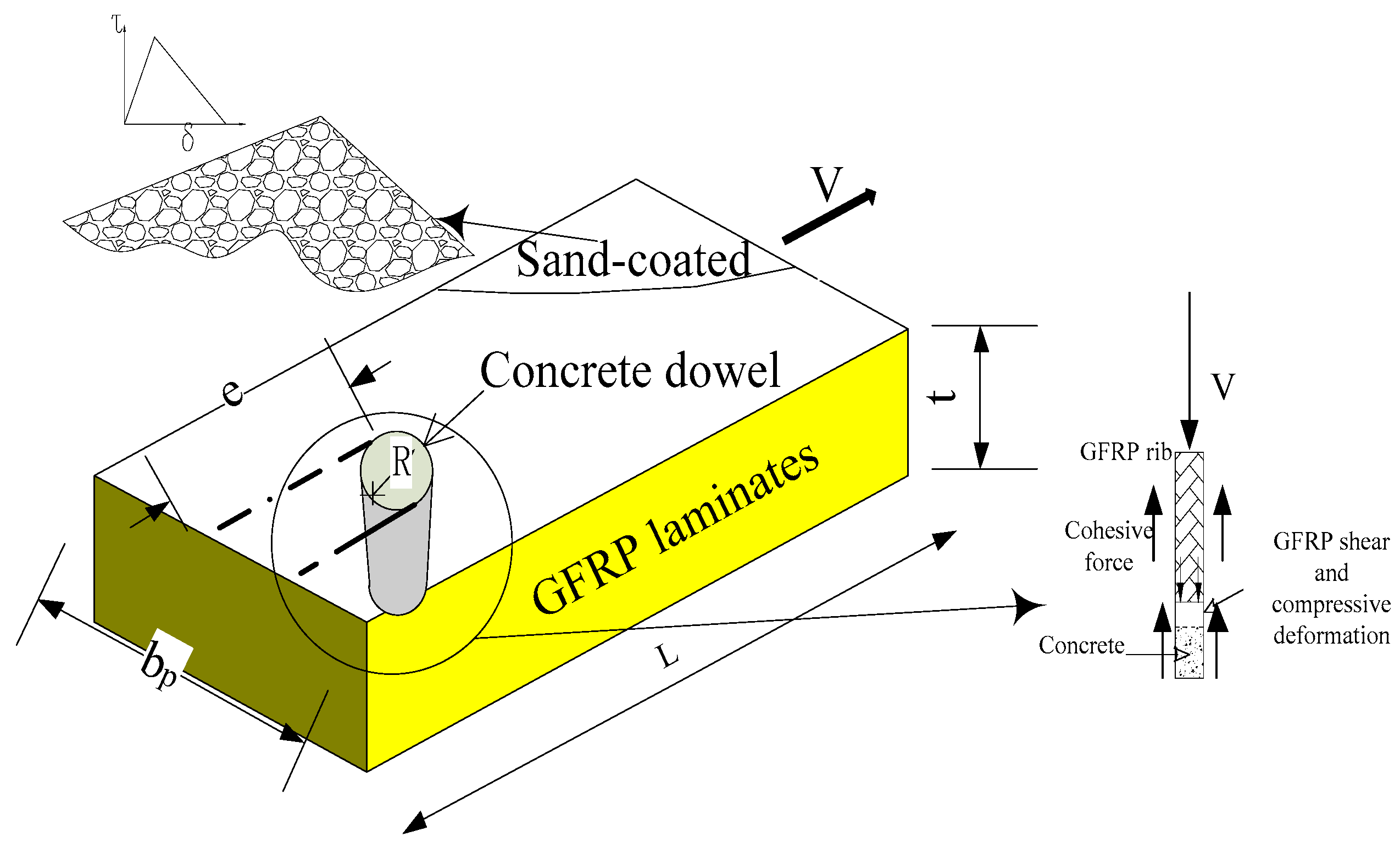1. Introduction
Glass fiber-reinforced polymer (GFRP)-concrete composite structures have been widely used in infrastructure [
1,
2,
3,
4,
5]. The connection between GFRP and concrete is of great importance. The types of connection for GFRP-concrete composite structures includes bolt, sand-coated, and perforated. Since casting concrete directly on GFRP formwork results in poor bonding performance [
6], a sand-coated GFRP profile is a good option to increase the combination between concrete and GFRP. Cho et al. tested a sand-coated GFRP-concrete bridge deck with bolted connection [
7], the fatigue performance of sand-coated GFRP-concrete deck was significantly improved by the presence of the bolt. Woltman et al. [
8] investigated the pull-out performance of a shear connector made of sand-coated GFRP rebars which presented a higher strength than the specialized polymer connector. However, it has been reported that the humid environment may cause bond degradation [
9]. In the meantime, a perforated plate connection is widely used and preferred in steel-concrete composite structures [
10,
11]. The combination of sand-coated surface and perforated plate has been tested in composite slabs by the authors [
12]. It has been found that the flexural resistance of slabs with sand-coated GFRP perforated connectors (SCGPC) was much larger than that of slab without surface treatment. It is still unclear about the improvement of the shear capacity of SCGPC than that of plate without surface treatment.
Generally, the bond behaviors between sand-coated fiber-reinforced polymer (FRP) plate and concrete are characterized by bond strength, effective bond length, and load-slip curve. In FRP strengthening concrete structures, concrete strength has been found to have a substantial effect on the adhesion strength. Chen and Teng developed a model based on nonlinear fracture mechanics and test data for the externally bonded FRP [
13] in which the ultimate adhesion strength is proportional to the square root of concrete cylinder compressive strength
fc’. Seracino [
14] proposed a generic model considering both externally bonded FRP sheets/plates and near-surface mounted FRP strips, in which the ultimate adhesion strength is proportional to
fc’
0.33 similar as Bilotta [
15]. Kalupahana [
16] carried out a series of 44 near-surface mounted carbon fiber-reinforced polymer (CFRP) tests indicating that the concrete strength effect on the ultimate strength depends on the FRP’s surface configuration and the embedment length.
Effective bond length
Le (also called critical bond length) is a definition of FRP’s embedment length at which the adhesion resistance will reach the maximum and will not develop as the length enlarges [
13]. Seracino suggested a minimum 200 mm effective bond length for near-surface mounted CFRP by pull-out tests [
17]. Naser et al. conducted a series of tests and numerical investigations on the optimum embedment length of CFRP laminate [
18]. As regard to the load-slip curve, it is a reflection of interfacial traction-separation constitution. The push/pull-out tests of sand-coated FRP plate/rebar, finite element (FE) simulation is a regular tool to investigate the bond behavior [
19]. Cohesive zone modeling (CZM) is one of the most common methods in FE simulation, such as: Chen and EL [
20] used CZM to obtain mixed-mode bending fracture energy of the interface between sand-coated GFRP and UHPC; and Tekle et al. [
21] implemented CZM to investigate strand and bond distribution along the sand-coated GFRP bars. Besides, the tests about the roughness of sand-coated surface have been done to understand its effect on adhesion strength, however, the result showed a scatter about the adhesion resistance and the aggregate size [
22,
23].
In terms of GFRP perforated connectors (GPC) embedded in concrete, push/pull-out tests have been reported. Based on the experimental findings, Cho et al. [
24] proposed a strength equation on the basis of discrete spring model; Zou et al. [
25] proposed a strength equation on the basis of the Oguejiofor and Hosain Model; and the authors [
26] proposed a strength equation considering the effect of stress concentration of GFRP hole.
Although plenty of previous tests and analysis have been performed on sand-coated FRP joint and GPC, SCGPC involves the interaction between the perforated GFRP plate and concrete, knowledge on the shear behavior of SCGPC is limited as far as the authors’ knowledge. Furthermore, the shear capacity of SCGPC or the comparison between SCGPC and GPC, these issues are quite important yet haven’t been reported. This paper carried out experimental and numerical investigations to reveal the failure mechanism of SCGPC and to understand the shear behavior of SCGPC. The novelty of this research embodied in the following aspects: (1) the shear failure mode of SCGPC was found and compared to that of GPC, which provided a reference to the structural design; (2) FE model of SCGPC based on lamina theory was built and validated by pull-out test. CZM was incorporated in the FE model and presented a precise capture of the bond behavior of SCGPC; and (3) an empirical equation was proposed to predict the strength of SCGPC.
4. Parametric Analysis Result
The load-slip curves of parametric analysis are plotted in
Figure 13. It is found that the SCGPC’s shear capacity is considerably larger than that of GPC, and the SCGPC is more ductile than the sand-coated plate when bearing load. The load-slip curves of SCGPC presents a similar yield plateau especially when the embedment length is larger than critical value as
Figure 13a–c.
By generalizing the load-slip curves of
Figure 13d–i, the failure process can be illustrated as
Figure 14. At the initial stage from point O to point A, the adhesion holds the contact force between the plate and concrete and degrades swiftly as the cohesive damage contour reflects. From point B to point C, the bond resistance drops rapidly and GFRP plate starts to damage. When reaching the peak load point C, GFRP plate appears large area of matrix compressive damage. Finally, the plate presents the shear failure as GPC.
With the knowledge of the failure process as shown in
Figure 14, two points are understood about SCGPC specimens of embedment length 150–200 mm, (i) the bond failure is prior to the GFRP shear failure; and (ii) the plate’s failure pattern is the same as that of GPC. According to previous research [
26], for the plate shear failure of GPC, there is a critical plate thickness
tcr. When the plate is thinner than
tcr, the plate tends to appear shear failure, on the contrary, GPC turns up concrete dowel failure. According to the prediction in [
26], plate thickness of GPC with the same dimension should be at least 10 mm to meet the requirement of
tcr, therefore, 6 mm thickness is thinner than
tcr. In other word, the plate’s failure pattern of SCGPC fits the theory of shear failure of GPC.
Next, the parameters affecting the shear capacity of SCGPC have been addressed separately, which included embedment length, radius, multi-hole, and penetrating rebar.
Firstly, the embedment length indicated a significant impact on the shear strength of SCGPC as shown in
Figure 15a. Especially when radius is fairly small like
R = 25 mm, SCGPC behaved as similar as sand-coated plate. In terms of the previous literature [
13], shear strength of external bonding of GFRP won’t improve significantly if the embedment reaches its effective bond length. According to Cheng and Teng model [
13], effective bond length
Le can be determined as Equation (9), where
fc’ and
Ep are concrete cylinder strength and FRP’s elastic modulus, respectively. However, the sand-coated embedment of SCGPC is analogous to the near-surface mounted strip, its debonding mechanism is different from the external bonding [
14]. Substituting the material property in this research to Equation (9),
Le = 296 mm. For the type of E-300 specimens, the embedment length
L is larger than
Le. It can also be observed from
Figure 15a, when embedment length ascended from 200 to 300mm, the secant of the curves all became flatter than the initial stage.
On the mean time, concrete strength actually is another major factor affecting the strength of SCGPC. Including the definition of effective bond length
Le, GFRP plate’s critical thickness
tcr, and the empirical equation of SCGPC’s shear strength in the next section, concrete strength has been all involved in. Therefore, it is not discussed alone in this article.
As regard to the effect of hole’s radius, it is presented in
Figure 15b. When embedment length is deep, the strength of SCGPC decreased with the increasing radius. This is attributed to the discounted bond capacity due to the perforated area. Hole’s radius makes insignificant effect on SCGPC’s strength when embedment length is short like E = 200 mm. Although the bond capacity decreases as the radius increases, the counteraction of the ascending strength of GPC makes the strength of SCGPC stay still.
With respect to the effect of multi-hole, the double-hole specimen’s strength was less than two times of single hole specimen, this could be owing to larger stress concentration. Comparing the strength of NS-R25-E300 and test specimens SC-R25, it was found the penetrating rebar didn’t play a role in the GFRP shear failure, which has also been reported by the previous test [
26].
5. Failure Mechanism and Empirical Equation
Through the parametric analysis and its discussion, when GFRP plate’s thickness is less than the critical thickness
tcr, SCGPC’s failure mode can be classified into two situations: (1) bond failure governing if
L ≥
Le; and (2) a mixture of bond failure and GFRP shear failure if
L <
Le. In the first circumstance
L ≥
Le, the bond resistance governs the strength of SCGPC like SC-E300 in
Figure 13a–c, while the strength of SCGPC is less than the pure sand-coated plate since there is perforated area. In the second circumstance
L <
Le, sand-coated surface of SCGPC debonds initially and then the GFRP plate bears the shear load and fails at last as shown in
Figure 14. In
Figure 13, the stiffness of the SCGPC is obviously larger than that of GPC and is determined by the bond strength. The failure process and mechanism are illustrated in
Figure 14 and
Figure 16, respectively.
According to the failure mechanism of SCGPC, an empirical equation is suggested. The empirical equation predicts the strength in two regions by the value of
L. When
L ≥
Le, it is assumed that the strength of SCGPC is governed by the bond resistance given by Equation (10), which has been proposed by Seracino [
14] and is modified to consider the reduction effect caused by the perforated area. In Equation (10),
Lper = 2(
L+1)+(
bp+1);
ϕf = (
L+1)/(
bp+1);
Ap is FRP’s shear area,
frup is FRP’s rupture stress; all the length unit is millimeters; and when
L <
Le, it is assumed that the strength is composed of post-peak resistance of the adhesion and the GPC’s shear resistance
VGPC, which is then written as Equation (11). In Equation (11),
VGPC has been reported as Equation (12) [
26], effective bond length
Le is determined by Equation (9),
βL is a coefficient reflecting the ratio between embedment length to effective bond length and is obtained by Equation (13).
Parametric analysis results of SCGPC have been used to validate the suggested empirical equation. The prediction by Equations (10) and (11) are summarized in
Table 6, which shows a mean deviation −0.07 between the prediction by the suggested equations and FE simulation. The prediction of empirical equation matches the strength from FE analysis. The precondition of Equations (10) and (11) is GFRP plate thickness
t <
tcr. When
t ≥
tcr, it may relate to the resistance of the concrete dowel, which is not the objective of this paper.

